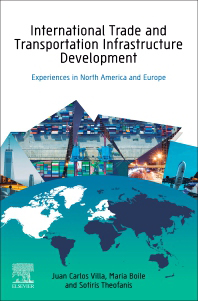
Texas A&M Transportation Institute (TTI) Research Scientist Juan Carlos Villa published International Trade and Transportation Infrastructure Development: Experiences in North America and Europe (1st edition) Apr. 24, 2020, on Elsevier’s publisher platform. Villa is a co-author with Maria Boile, director of the Hellenic Institute of Transport, part of the Center for Research and Technology Hellas, in Greece, and Sotirios Theofanis, board chairman and chief executive officer of the Thessaloniki Port Authority S.A. and board member of the South Europe Gateway Thessaloniki in Greece. Both Boile and Theofanis are senior research scientists at Rutgers University’s Center for Advanced Infrastructure and Transportation.
Villa manages TTI’s Mexico City Office, where he oversees research in freight transportation, logistics and trade. He has nearly four decades of experience with research in the United States, Europe, Mexico and other Latin American countries. He serves as a member of the U.S. Department of Commerce’s Committee on Supply Chain Competitiveness and chairs the Transportation Research Board’s International Trade and Transportation Committee.
International Trade and Transportation Infrastructure Development: Experiences in North America and Europe analyzes how trade agreements, such as the North American Free Trade Agreement and the European Union Customs Union, impact transportation systems and infrastructure in the member countries. This analysis takes a broad, historical perspective, categorizing trade by mode over time, examining modal shifts related to trade policy and disputes, and recognizing the modal shifts’ implications for all involved countries. The book’s topics include:
- supply and demand trends with a review of transportation processes and stakeholders,
- each trade mode’s related policies, capacity development, funding mechanisms, and operational characteristics, and
- disruptive technologies’ recent trends, impact on transportation, and potential regulatory changes (especially regarding infrastructure plans, project funding and operations).
The book’s main audience is transportation practitioners involved in planning, feasibility studies, consultation, and/or policy for international transportation systems or infrastructure. The book can also be helpful for transportation public officials, such as federal, state, regional, and/or city managers, as well as academic researchers and graduate students focused on transportation planning, international relations, trade, and related fields of study.
“This book starts with a clear description of the relationship between transportation infrastructure and trade, followed by a comprehensive narrative of the waterway, road and railway systems in North America and Europe,” says Villa. “Trade flow evolution in North America and across the globe sets the stage for a better understanding of transportation needs. The North American transportation system is described in detail including the planning, funding and development processes. The book’s final chapter lays out a future outlook of world trade and transportation, particularly with regard to new technological developments and disruptions. This book offers readers a one-stop shop for insights on trade and transportation in North America and Europe.”